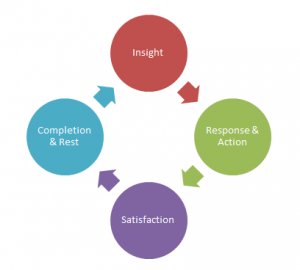With Somatic Psychotherapy
“The body has experience, the mind interprets experience, the environment stimulates experience.” ~Ron Kurtz
Hierarchy of Experience – Exploring the Mind-Body Connection
In our lives, most of us get locked in to one channel – thoughts and language. However, when we want to break out of what we  know, and what we have always been doing, it is helpful to move into the realm of the unconscious. To do that, we have to engage with other channels to gather new information. I love working with clients who have tried therapy with other therapists that engage only in talk and leave thinking therapy doesn’t work, but are still motivated to create change in their lives. If you are ready to move beyond talk into deeper experience, here are some more paths to explore.
know, and what we have always been doing, it is helpful to move into the realm of the unconscious. To do that, we have to engage with other channels to gather new information. I love working with clients who have tried therapy with other therapists that engage only in talk and leave thinking therapy doesn’t work, but are still motivated to create change in their lives. If you are ready to move beyond talk into deeper experience, here are some more paths to explore.
In a simplified representation of the brain, we can see other parts of the brain hold information and patterns that are also beneficial to access in therapy.
Reptilian Brain – Brain Stem and lower brain components – basic survival and life support functions like breathing, heart rate, digestion, movement, fight/flight/freeze response. Many shared structures with reptiles and animals.
Animal Brain – Midbrain – Limbic system/emotional/relational systems. Passes and filters information between body/sensory information, brain stem, and rational thinking brain.
Human Brain – Cerebral Cortex – especially Frontal Lobe. Top and most recent area of our brain to evolve. What makes us humans unique. Responsible for thought, language, meaning, logic, sequencing, right/wrong.
Standard talk or cognitive behavioral therapy only engages with the conscious, primarily the frontal lobe. This is effective in some cases, but not all information is accessible through logic and words. Engaging with other information sources we access other parts of the brain, which gives us access to deeper patterns, memories, and unconscious material.
The main channels we explore in somatic psychotherapy are:
Thoughts – words, narrative, internal dialog, automatic voices, etc. Information comes from the frontal lobes and left hemisphere primarily.
Tensions/Impulses – Places our body is tight, holding, posture, desires to move in some way that are inhibited. Information comes from basal ganglia, and hypothalamus.
Sensations in the Body – Can take many forms. Pain, sore, tender, energetic, shapes, temperatures, colors, walls, etc. Information comes from limbic system.
Emotions – Sadness, joy, anger, fear, etc. Information comes from limbic system, especially amygdala.
Memories – Past events which shape our beliefs and learning. Information from hippocampus, amygdala, cortex, and other sensory centers (visual, auditory, olfactory, movement, sensation, etc.)
Meaning – The lessons you learned from memories and experiences and what is important about it.
Core Beliefs – Patterns and rules we develop implicitly and explicitly about our world which guide present behavior and experience. Information comes from many parts, especially limbic system, needs to be reconnected with cerebral cortex to bring awareness and choice.
By studying and gathering information in all of these layers, we can gain access to the deeper patterns that lay outside of our conscious awareness which we miss only engaging in talk. Then we start to become more aware of:
Strategies – How we organize (mostly unconsciously) our behavior, relationships, thoughts, expression, inhibitions, and more. Often a result of attempts to get our needs met, despite having the experiences, rules, and beliefs we do.
Healing Relationship
We explore these sources of information and experience in the context of relationship. We can gather some of this information on our own, but we need an environment and human relationship to stir the pot. If we are limited to only self-exploration, we are staying within the system and existing patterns. Having a human relationship helps us explore the places we wouldn’t normally go on our own. And even more importantly, provides a non-judgmental, kind, loving, accepting relationship to help us heal the tender and sensitive parts of us. And having this experience helps teach us how to have a more kind, non-judgmental, loving, accepting relationship with ourselves.
My goal is to help people reconnect first to themselves; to their own heart, mind, and body. Then reconnect to people in their lives. Then eventually reconnect to the larger world in all of its complex systems in a more healthy way. When people can feel what real connection feels like, then they can bring that connection back to their families and friends. Once people have felt true connection, they don’t want to settle for anything less. When we restore connection, we restore hope.
Mindfulness
Mindfulness is simply awareness of present moment experiences with an attitude of acceptance, curiosity, and the ability to stay without needing anything to change. The ability to stay with discomfort, witness it, and learn from it. Mindfulness in therapy serves us in several ways. Primarily, it helps us to lower the noise inside and become more sensitive to what our systems are already communicating. Just as important, is the ability to witness, not identify with the patterns, thoughts, emotions, and sensations we see. Mindfulness expands the container. We are not our patterns, but it feels like that when we don’t have the big picture view that comes with mindfulness.
Mindfulness in psychotherapy is NOT to help us relax and feel better, to fix things, to make anything go away. This is often a side-effect that happens over time, but seeking to relax and feel better immediately can result in building new walls and closing down to important information. Our goal is to open to what is there, work with it, learn from it, heal it, and transform our relationship to it so that it is not running the show unconsciously anymore.
Sensitivity Cycle – A process map
One of the maps I use to help guide people through growth and change is the Sensitivity Cycle. It helps us to understand what is missing, and what needs to happen next. It is called th e Sensitivity Cycle, because following it through once completes one cycle of change. Following it through many iterations leads to deeper self-knowledge and increasing sensitivity to ones patterns.
e Sensitivity Cycle, because following it through once completes one cycle of change. Following it through many iterations leads to deeper self-knowledge and increasing sensitivity to ones patterns.
- First we need information/insight. What is this? Why is it important? Where does it show up? (It is important to not this is the first step – not the last or only step.)
- Next we need to be able to take action based on that information. We need an experience. Knowing this, how do I respond well? How do I cope, express, master?
- Next we need to be able to be satisfied with our action. How do I be content, nourished, accepting, fulfilled?
- Finally we need to be able to relax and feel complete. Can I rest, trust, integrate, be at peace?
This process is actually a circle, or spiral. It repeats, indefinitely through many layers as the relationship deepens. We can experience this cycle in many micro and macro levels, but when we look closely, we see we often get stuck at one point in the cycle. But when we can move through all of these steps well, we spiral into deeper knowledge and long lasting changes of our patterns.
~chuck
What do you think? Better yet, what do you feel? What do you experience? Let’s continue the conversation! You can find me at www.innerlifeadventures.com or email [email protected]. Want to meet? Here’s how.
Chuck Hancock, M.Ed, LPC is a National Certified Counselor, Licensed Professional Counselor, and a Registered Psychotherapist in the state of CO. He has completed comprehensive training in the Hakomi Method of Experiential Psychotherapy, a mindfulness mind-body centered approach. Chuck guides individuals and groups in self-exploration providing them with insight and tools for change. He also incorporates nature as a therapy tool to help shift perspective and inspire new patterns.

